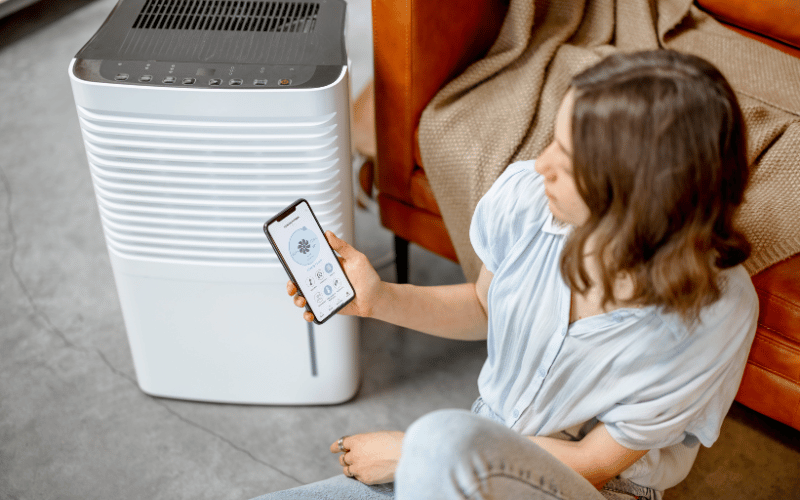Airborne allergens can have a big impact on your health.
Dust can lead to breathing difficulties. If there are damp areas in your house, you might find mold, which can cause significant property damage and respiratory illnesses. Fortunately, there are ways to remove harmful airborne particulates from your home. One of the best ways to do this is by using a whole-house air purifier.
How Does a Whole-House Air Purifier Work?
Whole-house air purifiers often connect to an existing heating, ventilation, and air conditioning (HVAC) system. As air passes through the HVAC system, it goes through the air purifier’s filters to remove particulates. There are a few common types of whole-house air purification systems:
- Activated carbon filters: These filters help control humidity and absorb odors, gas pollutants, and volatile organic compounds (VOCs).
- HEPA filters: These filters force air through a fine mesh to trap dust, pet dander, pollen, and smoke and realistically remove up to 99.97% of allergens.
- Negative ion generators: These machines electrically charge air particles so they stick to surfaces instead of circulating. Sometimes, other filters have an ionizer setting on them.
- UV light systems: These devices kill mold, bacteria, viruses, and other microbes as the air passes by the ultraviolet light source.
In many types of devices, the air passes through multiple filters and purification stages as part of your home’s HVAC system airflow. This way, impurities are continually scrubbed from the indoor air.
Benefits of Whole-House Air Purification
There are many benefits to whole-house air purifiers. They integrate seamlessly into existing HVAC system airflows, which means that they clean the air in every room. Stand-alone units, on the other hand, are only able to purify one room at a time. They also require less maintenance than multiple units. It is often cheaper to have one central system versus many single-room cleaners.
Whole-house air purifiers provide cleaner indoor air for those with allergies or asthma. They protect against airborne illnesses and particles and remove musty smells and strong chemical odors. Some filters also have smart features like air quality alerts.
Key Buying Considerations
When shopping for a whole-house air purifier, I recommend considering the following features.
First, you should consider what types of air pollutants you want to remove, such as allergens, odors, or microbes. You should choose a system with the appropriate filtration for your needs.
Undersizing may lead to inadequate air cleaning. So, you should also consider air changes per hour (ACH). Faster ACH rates mean that the air purifies more quickly. Look for eight to 12 ACH for efficient performance. Many systems also have features like filter change reminders, air quality monitors, smartphone app connectivity, and adjustable fan speeds. You want to select a filter that means those needs.
Finally, you should consider the cost of the filter. Most up-front purchase prices average $574 but could cost as much as $1300, depending on the system type. This price includes installation fees and ongoing filter replacement costs.
It is best to verify the purification system meets the requirements for the square footage of your home per manufacturer guidelines.
Alternative DIY Options
You may decide that a whole-house purification system is not practical. In this case, you can choose a DIY option. However, these systems usually require more effort. Some DIY air filtration systems include:
- In-duct filters: This requires you to add a filter inside a ductwork. The air is cleaned as it passes through the duct.
- Stand-alone air purifiers: You can place air filters in specific rooms.
- Upgraded furnace filters: You can choose to install a better quality disposable filter with higher MERV ratings to filter more allergens.
DIY options tend to be less effective than comprehensive whole-house air purification. But they offer more customization options.

So, Is Investing in Whole-House Air Purification Worth It?
Installing an air purifying system can greatly improve your indoor air quality if you have allergies or asthma or want cleaner air. Built-in HVAC cleaners filter allergens, chemicals, and pollutants as air circulates through your home.
Whole-house units can be expensive and will likely require professional installation. However, they are more efficient than individual room units and can result in greater cost savings over time. You also do not have to worry about moving stand-alone units from room to room all the time. The return of cleaner air and better health makes whole-house systems worth it for many homeowners.
FAQs About Whole-House Air Purifiers
Which system is better — HEPA or UV?
It depends on which type of particles you wish to remove. HEPA filters excel at removing allergens. UV lights specialize in killing mold, bacteria, and viruses. Many whole-house units combine both for comprehensive air purification.
Where do I install the air purifier?
Most whole-house air purifiers connect to your home’s HVAC system, often your furnace or air handler. This setup lets them filter air as it circulates through your ductwork to clean every room.
How often should filters be replaced?
Filter replacement timing depends on the type of system and how often you run it. Many systems have reminders to prompt you to change them. In general, it is best to replace HEPA filters every six to twelve months, UV bulbs at least once a year, and carbon filters every three to six months.
Can air purifiers reduce mold?
Yes. UV lights kill mold spores and growth when they pass over the bulb. HEPA filters capture mold spores as well.
Should your whole-house air purifier run all the time?
I recommend running your whole-house air purifying system whenever your home’s HVAC is heating or cooling.












